1 , an overview of the classification of the container
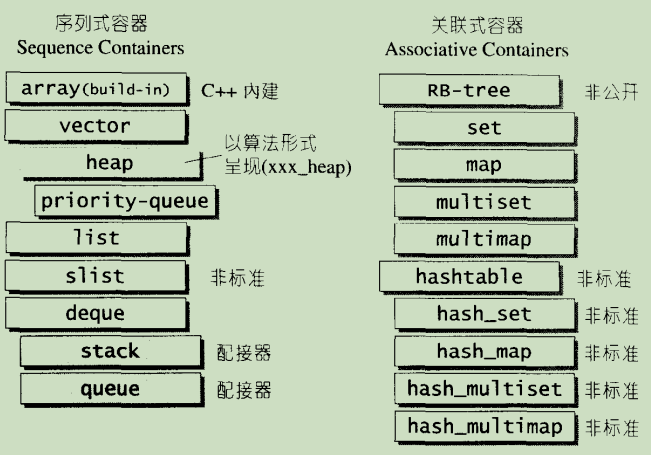
The so-called container sequence, wherein the sequence elements can be (ordered) [for example may be used to sort the sort], but not necessarily ordered (sorted). C ++ language itself provides a sequence of container array, STL provide an additional vector, list, deque, stack, queue, priority-queue sequence like containers. Since only the queue stack and wherein the deque from head Plane, is classified as a technology adapter (adapter).
2、vector
the vector data arrangement and mode of operation is very similar to the array. The only difference is that the flexibility of the use of space.
array is a static space , once the configuration can not be changed; be another big (or small) a little house, you can, all too trivial by the client themselves: first configure a new space, and then the elements from the site of eleven moved to new premises , then releases them back to the original system.
vector is a dynamic space , with the addition of elements, it will expand its own internal mechanisms of space to accommodate the new element. Therefore, the use of vector is a great help for the rational use of memory and application flexibility, we no longer have to fear a lack of space and the beginning of a big array of requirements, we can feel at ease using the vector, how much how much to eat with.
- Common source:
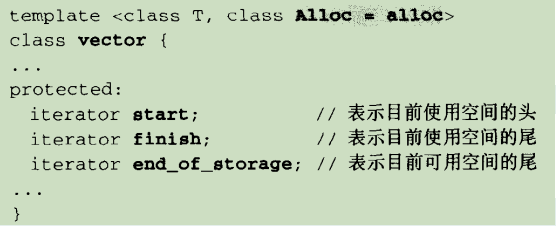
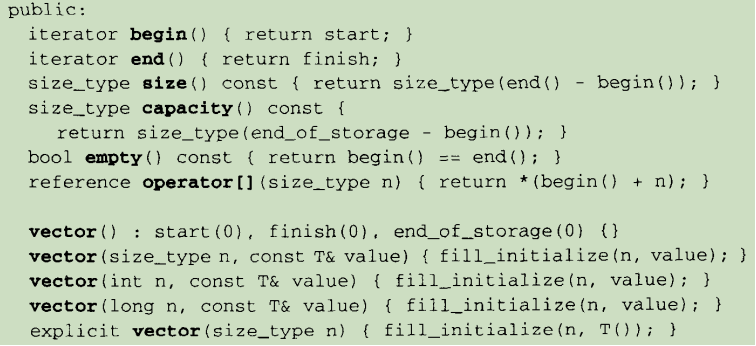


note:
- size() & captical:
It indicates the size of the stored data, and the capital is the size of the internal open space
Therefore, in the erase, pop_back, clear, etc. deletion, such that it will not produce a change captial, is only becomes size ()
- Dynamic space allocation:
注意,所谓动态增加大小,并不是在原空间之后接续新空间(因为无法保证原空间之后尚有可供配置的空间),而是以原大小的两倍另外配置一块较大空间,然后将原内容拷贝过来,然后才开始在原内容之后构造新元素,并释放原空间。因此,对vector的任何操作,一旦引起空间重新配置,指向原vector的所有迭代器就都失效了。这是程序员易犯的一个错误,务需小心。
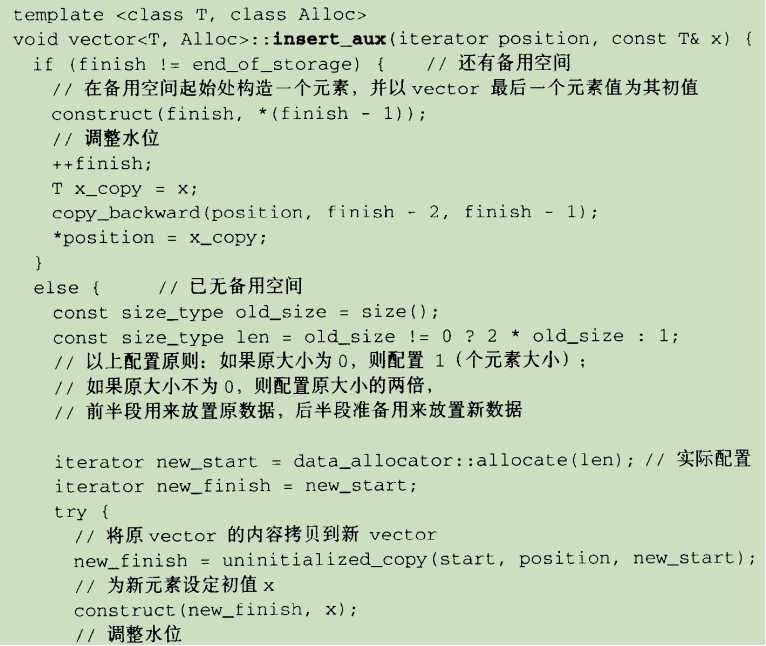

- insert():
insert()会根据需要插入元素的位置p以及p后面的元素个数与需要插入元素个数n进行比较,分两种情况进行插入

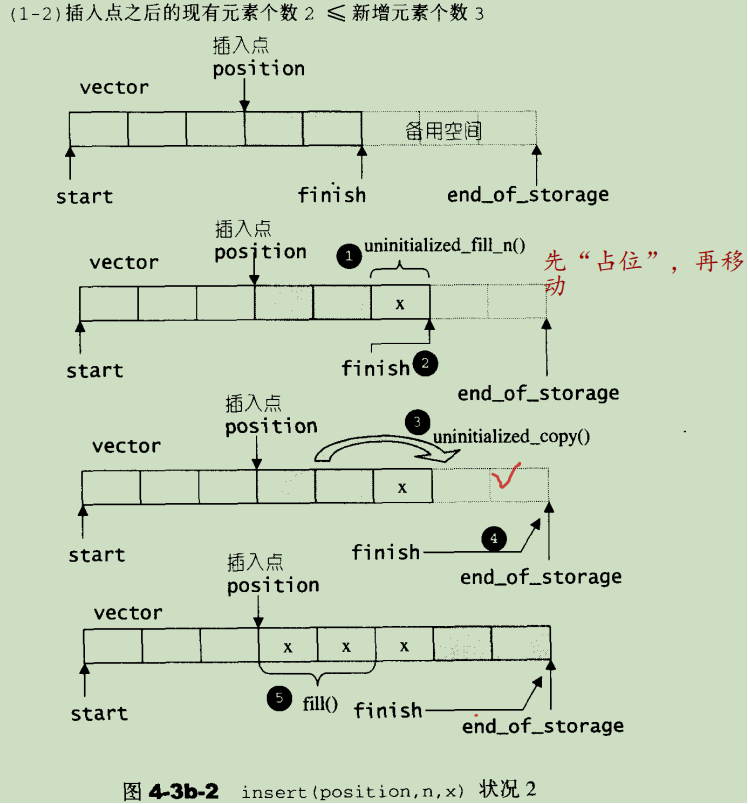
- emplace_back() VS push_back()减少内存拷贝和移动
1 struct President 2 { 3 President(std::string && p_name, std::string && p_country, int p_year) 4 : name(std::move(p_name)), country(std::move(p_country)), year(p_year) 5 { 6 std::cout << "I am being constructed.\n"; 7 } 8 President(President&& other) 9 : name(std::move(other.name)), country(std::move(other.country)), year(other.year) 10 { 11 std::cout << "I am being moved.\n"; 12 } 13 President& operator=(const President& other) = default; 14 }; 15 16 int main() 17 { 18 std::vector<President> elections; 19 std::cout << "emplace_back:\n"; 20 elections.emplace_back("Nelson Mandela", "South Africa", 1994); 21 22 std::vector<President> reElections; 23 std::cout << "\npush_back:\n"; 24 reElections.push_back(President("Franklin Delano Roosevelt", "the USA", 1936)); 25 } 26 emplace_back: 27 I am being constructed. 28 29 push_back: 30 I am being constructed. 31 I am being moved.
merge()函数:
merge方式要注意三点:
merge(vec1.begin(),vec1.end(),vec2.begin(),vec2.end(),vec3.begin());
1、vec1,和vec2需要经过排序,merge只能合并排序后的集合,不然会报错。
2、vec3需要指定好大小,不然会报错。
3、merge的时候指定vec3的位置一定要从begin开始,如果指定了end,它会认为没有空间,当然,中间的位置我没有试,回头有空试一下。
3、list
相较于vector的连续线性空间,1ist就显得复杂许多,它的好处是每次插人或删除一个元素,就配置或释放一个元素空间。因此,list 对于空间的运用有绝对的精准,一点也不浪费。而且,对于任何位置的元素插人或元素移除,list永远是常数时间。
由于STL1ist是一个双向链表(double linked-list),迭代器必须具备前移、后移的能力,所以1ist 提供的是Bidirectional lterators。
list 有一个重要性质:插入操作(insert)和接合操作(splice)都不会造成原有的list迭代器失效。这在vector是不成立的,因为vector的插入操作可能造成记忆体重新配置,导致原有的迭代器全部失效。甚至1ist的元素删除操作(erase),也只有“指向被删除元素”的那个迭代器失效,其它迭代器不受任何影响。

- SGI list 是一个环状双向链表,它只需要一个指针就可以完整表现整个链表
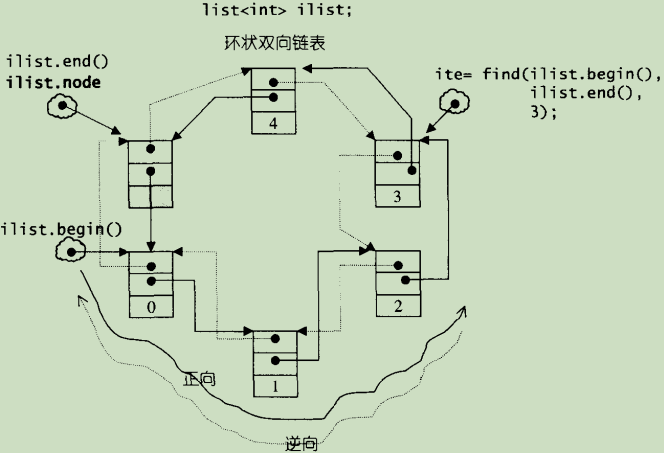
- list链表的初始结构:
node->next = node;
node->prv = node;

- .transfter() //迁移函数
void transfer(iterator position, iterator first, iterator last);
将list2的first-last之间的元素插入到list1中的position中
- .splice() //衔接函数
| void splice( const_iterator pos, list& other ); |
(1) |
|
| void splice( const_iterator pos, list&& other ); |
(1) |
(C++11 起) |
| void splice( const_iterator pos, list& other, const_iterator it ); |
(2) |
|
| void splice( const_iterator pos, list&& other, const_iterator it ); |
(2) |
(C++11 起) |
| void splice( const_iterator pos, list& other, const_iterator first, const_iterator last); |
(3) |
|
| void splice( const_iterator pos, list&& other, const_iterator first, const_iterator last ); |
(3) |
(C++11 起) |
从一个 list 转移元素给另一个。
不复制或移动元素,仅重指向链表结点的内部指针。若 get_allocator() != other.get_allocator() 则行为未定义。没有迭代器或引用被非法化,指向被移动元素的迭代器保持合法,但现在指代到 *this 中,而非到 other 中。
1) 从 other 转移所有元素到 *this 中。元素被插入到 pos 所指向的元素之前。操作后容器 other 变为空。若 other 与 *this 指代同一对象则行为未定义。
2) 从 other 转移 it 所指向的元素到 *this 。元素被插入到 pos 所指向的元素之前。
3) 从 other 转移范围 [first, last) 中的元素到 *this 。元素被插入到 pos 所指向的元素之前。若 pos 是范围 [first,last) 中的迭代器则行为未定义。
参数
| pos |
- |
将插入内容到其前的元素 |
| other |
- |
要自之转移内容的另一容器 |
| it |
- |
要从 other 转移到 *this 的元素 |
| first, last |
- |
要从 other 转移到 *this 的元素范围 |
- .merge()
| c1.merge(c2) |
//合并2个有序的链表并使之有序,从新放到c1里,释放c2。 |
| c1.merge(c2,comp) |
//合并2个有序的链表并使之按照自定义规则排序之后从新放到c1中,释放c2。 |
| c1.splice(c1.beg,c2) |
//将c2连接在c1的beg位置,释放c2 |
| c1.splice(c1.beg,c2,c2.beg) |
//将c2的beg位置的元素连接到c1的beg位置,并且在c2中释放掉beg位置的元素 |
| c1.splice(c1.beg,c2,c2.beg,c2.end) |
//将c2的[beg,end)位置的元素连接到c1的beg位置并且释放c2的[beg,end)位置的元素 |
归并二个已排序链表为一个。链表应以升序排序。
不复制元素。操作后容器 other 变为空。若 other 与 *this 指代同一对象则函数不做任何事。若 get_allocator() != other.get_allocator() ,则行为未定义。没有引用和迭代器变得非法,除了被移动元素的迭代器现在指代到 *this 中,而非到 other 中,第一版本用 operator< 比较元素,第二版本用给定的比较函数 comp 。
此操作是稳定的:对于二个链表中的等价元素,来自 *this 的元素始终前驱来自 other 的元素,而且 *this 和 other 的等价元素顺序不更改。
参数
| other |
- |
要交换的另一容器 |
| comp |
- |
比较函数对象(即满足比较 (Compare) 概念的对象),若第一参数小于(即先序于)第二参数则返回 true 。 比较函数的签名应等价于如下: bool cmp(const Type1 &a, const Type2 &b); 虽然签名不必有 const & ,函数也不能修改传递给它的对象,而且必须接受(可为 const 的)类型 Type1 与 Type2的值,无关乎值类别(从而不允许 Type1 & ,亦不允许 Type1 ,除非 Type1 的移动等价于复制 (C++11 起))。 类型 Type1 与 Type2 必须使得 list<T,Allocator>::const_iterator 类型的对象能在解引用后隐式转换到这两个类型。 |
4、deque
deque和vector的最大差异:【vector与deque都可以随机读取】
一在于deque允许于常数时间内对起头端进行元素的插入或移除操作,
二在于deque没有所谓容量(capacity)观念,因为它是动态地以分段连续空间组合而成,随时可以增加一段新的空间并链接起来。
- 中控器:
deque是连续空间(至少逻辑上看来如此)。
deque系由一段一段的定量连续空间构成。一旦有必要在deque的前端或尾端增加新空间,便配置一段定量连续空间,串接在整个deque的头端或尾端。
deque的最大任务,便是在这些分段的定量连续空间上,维护其整体连续的假象,并提供随机存取的接口。避开了“重新配置、复制、释放”的轮回,代价则是复杂的迭代器架构。
deque采用一块所谓的map(注意,不是STL的map容器)作为主控。这里所谓map是一小块连续空间,其中每个元素(此处称为一个节点,node)都是指针,指向另一段(较大的)连续线性空间,称为缓冲区。缓冲区才是deque的储存空间主体。SGI STL允许我们指定缓冲区大小,默认值0表示将使用512bytes缓冲区。
当map的空间也不够后,会开辟另一个大的map空间

- 迭代器:
deque是分段连续空间。维持其“整体连续”假象的任务,落在了迭代器的operator++和operator--两个运算子身上。

- 数据结构:
- deque 除了维护一个先前说过的指向map的指针外,也维护 start,finish两个迭代器,分别指向第一缓冲区的第一个元素和最后缓冲区的最后一个元素(的下一位置)。此外,它当然也必须记住目前的map大小。因为一旦map所提供的节点不足,就必须重新配置更大的一块map。
- 什么时候map需要重新整治?这个问题的判断由 reserve_map_at_back()和 reserve_map_at_front()进行,实际操作则由reallocate_map()执行;
- 一个deque对象包含四个成员变量,_M_map指向主控器,_M_map_size表示中控器的大小,能够容纳多少个指针,_M_start表示deque的迭代器,所有元素的起始位置,_M_finish表示deque的迭代器,所有元素的终止位置。
- deque的insert()操作:首先判断插入的地方是头或者尾,如果都不是则在调用一个名为insert_aux的辅助函数。此辅助函数通过判断当前的插入位置更靠近头端或者尾端。
- deque的+=操作:首先判断是否在同一级缓冲区区域,如果不在,在确定应该夸几个缓冲区,然后到相应的缓冲区后,再移动
5、stack
- sack定义完整列表
deque是双向开口的数据结构,若以deque为底部结构并封闭其头端开口,便轻而易举地形成了一个stack。因此,SGI STL便以deque作为缺省情况下的stack底部结构,stack的实现因而非常简单,源代码十分简短,
- stack没有迭代器
- 以list作为stack的底层容器
6、queue
- queue定义完整列表
- deque是双向开口的数据结构,若以deque为底部结构并封闭其底端的出口和前端的入口,便轻而易举地形成了一个queue。因此,SGISTL便以deque作为缺省情况下的queue底部结构,queue的实现因而非常简单。
- queue没有迭代器
- 以list作为queue的底层容器
- 优先队列
- priority_queue<Type, Container, Functional>
7、 heap(隐式表述,implicit representation)【堆排序】
- 概念
heap并不归属于STL容器组件,它是个幕后英雄,扮演priority queue
的助手。顾名思义,priority queue允许用户以任何次序将任何元素推入容器内,但取出时一定是从优先权最高(也就是数值最高)的元素开始取。binary max heap正是具有这样的特性,适合作为priority queue的底层机制。
如果使用list作为priority queue的底层机制,元素插入操作可享常数时间。但是要找到list中的极值,却需要对整个list进行线性扫描。我们也可以改变做法,让元素插人前先经过排序这一关,使得list的元素值总是由小到大(或由大到小),但这么一来,收之东隅却失之桑榆:虽然取得极值以及元素删除操作达到最高效率,可元素的插入却只有线性表现。
以binary search tree作为priority queue的底层机制。这么一来,元素的插入和极值的取得就有O(logN)的表现。
但杀鸡用牛刀,未免小题大做,一来binary search tree的输入需要足够的随机性,二来binary search tree并不容易实现。priority queue的复杂度,最好介于queue和binary search tree 之间,才算适得其所。binary heap便是这种条件下的适当候选人。
binary heap就是一种 complete binary tree(完全二叉树)2,也就是说,整棵binary tree除了最底层的叶节点(s)之外,是填满的,而最底层的叶节点(s)由左至右又不得有空隙。【即是一棵完全搜索二叉树】
- heap算法
- push_heap
实现的是堆排序中的插入操作
1 //向上调整 2 void upAdjust(int L, int R) 3 { 4 int i = R, j = (i - 1) / 2;//i为欲调整结点,j为其父亲 5 while (j >= L) 6 { 7 if (v[j] < v[i])//父节点小了,那么就将孩子节点调上来 8 { 9 swap(v[i], v[j]); 10 i = j; 11 j = (i - 1) / 2;//继续向上遍历 12 } 13 else//无需调整 14 break; 15 } 16 } 17 void insert(int x) 18 { 19 v[n] = x;//将新加入的值放置在数组的最后,切记保证数组空间充足 20 upAdjust(0, n);//向上调整新加入的结点n 21 }
- pop_heap
实现的是堆排序的删除操作pop_heap -
1 //向下调整 2 void downAdjust(int L, int R) 3 { 4 int i = L, j = 2 * L + 1;//i为父节点,j为左子节点 5 while (j <= R) 6 { 7 if (j + 1 <= R && v[j + 1] > v[j])//若有右节点,且右节点大,那么就选右节点,即选取最大的子节点与父节点对比 8 ++j;//选取了右节点 9 if (v[j] <= v[i])//孩子节点都比父节点小,满足条件,无需调整 10 break; 11 //不满足的话,那么我就将最大孩子节点j与父节点i对调, 12 swap(v[i], v[j]); 13 i = j; 14 j = 2 * i + 1;//继续向下遍历 15 } 16 } 17 18 //删除堆顶元素 19 20 void deleteTop() 21 { 22 v[0] = v[n - 1];//也就是堆顶使用最后一个数值来替代 23 downAdjust(0, n - 2);//然后对前n-1个数进行排序 24 }
- sort_heap
就是不断的pop出最大的元素sort_heap
实现的就是堆排序
1 for (int i = n - 1; i > 0; --i)//从最后开始交换,直到只剩下最后一个数字 2 { 3 swap(v[i], v[0]);//每次都将最大值放到最后 4 downAdjust(0, i - 1);//将前0-i个数字重新构成大根堆 5 }
- make_heap
实现的是堆排序的构建
1 //建堆 2 void createHeap() 3 { 4 for (int i = n / 2; i >= 0; --i) 5 downAdjust(i, n - 1); 6 }
- heap没有迭代器
8、 priority_queue
- 概念
- priority_queue带有权值观念,其内的元素并非依照被推入的次序排列,而是自动依照元素的权值排列(通常权值以实值表示)。权值最高者,排在最前面。
- 定义
- 由于priority_queue 完全以底部容器为根据,再加上heap处理规则,所以其实现非常简单。缺省情况下是以vector为底部容器。具有这种“修改某物接口,形成另一种风貌”之性质者,称为adapter(配接器),因此,STL priority-queue往往不被归类为container(容器),而被归类为container adapter。
- 没有迭代器
9、slist
- 概述
- STL list是个双向链表(double linked list)。SGI STL另提供了一个单向链表(single linked list),名为slist。
- slist和list的主要差别在于,前者的迭代器属于单向的Forward lerator,后者的迭代器属于双向的Bidirectional lterator。单向链表所耗用的空间更小,某些操作更快,不失为另一种选择。
- 注意,根据STL的习惯,插入操作会将新元素插入于指定位置之前,而非之后。然而作为一个单向链表,slist没有任何方便的办法可以回头定出前一个位置,因此它必须从头找起。换句话说,除了slist起点处附近的区域之外,在其它位置上采用insert或erase操作函数,都属不智之举。这便是slist相较于1ist之下的大缺点。为此,slist 特别提供了insert_after()和erase_after()供灵活运用。
- 迭代器
10、常见错误总结:
迭代器失效:
·由于vector在扩容时,是在一块新地址上开辟空间,然后将原数据复制过来,并把原来的内存空间给释放了,所以一旦vector发生扩容,那么指向原来迭代器将会失效。
·由于list不是连续空间,所以删除和添加都在原的内存上添加或删除一个空间即可,所以指向原来的迭代器不会失效【除非该迭代器指向的位置被删除了】。
·迭代器不仅可以后移,而且可以前进的,--ptr, ++ptr